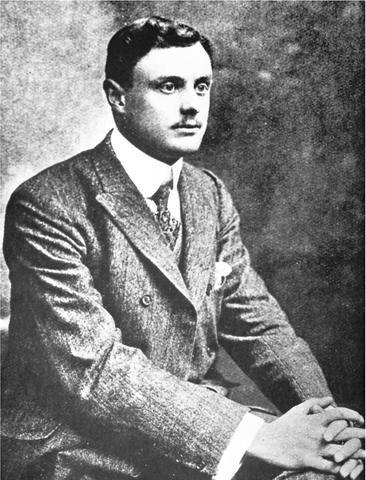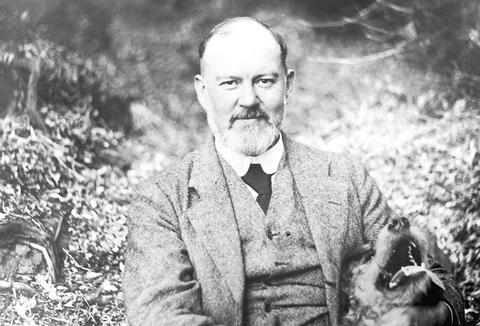Since 1904, Rolls-Royce has stood for everything that luxury and comfort can offer on four wheels: vehicles crafted by hand with exclusive leather and precious wood finishings.
But behind the story is the biography of two very different men who created "the best car in the world" out of virtually nothing. It is a history of many highlights and tragedy.

PHOTO: DPA
It was on May 4, 1904 that Charles Stewart Rolls and Frederick Henry Royce met for the first time in the Midland Hotel in Manchester. The two men could not be more different. Rolls was the wealthy son of an aristocrat, Royce a self-made businessman.

Born in 1863, Royce grew up in poverty as the fifth child of James Royce and Mary King. At the age of 10 he had to supplement the family income by selling newspapers and later worked as a telegraph boy.
His fate took a turn for the better when an aunt found him a job as an apprentice at the Great Northern Railway Works.
There Royce's natural talent for engineering was soon discovered. At the age of 21 he managed to establish with a friend his own firm, F.H. Royce & Co, producing electrical components and door knobs.
Charles Stewart Rolls was born 14 years later than Royce in the year 1877 as the third son of Lord and Lady Llangattock. He studied engineering at Cambridge and took part in races with everything that moved, from bicycles and motorcycles to cars.
In 1902 Rolls became a car trader, opening CS Rolls & Co in London. For a time in 1903, Rolls held the world speed record, driving a car at 150kph.
But there was something that really troubled him. All the cars he sold were imports and England was at the time still a developing country as far as motor vehicle production was concerned.
Royce was also familiar with the imports. In the course of the years he had become a wealthy man. There was a stock flotation in 1894 of his firm, which was by then building electric engines and electric cranes.
Taking an interest in the new technology he bought a French Decauville. But he soon was annoyed by the car's unreliability. Royce was not even satisfied after rebuilding the Decauville. He built his own car.
After the maiden drive in his car was a successs, he built two more cars -- one for his business partner Ernest Claremont and one for his friend Henry Edmunds, who was so thrilled with the car that he told a friend about it.
This friend, Claude Johnson, was a partner of Rolls.
Thereafter followed the first meeting of Rolls and Royce. After a test drive with the Royce car, Rolls was thrilled.
The 41-year-old businessman and the 27-year-old aristocrat quickly found common ground.
It was decided that Rolls would sell all the cars that Royce could build. The cars would be marketed under the name Rolls-Royce Motor Cars. In December 1904 the company presented two-, three- and four-cylinder cars at the Paris Motor Show.
But the real myth was created by a model presented in 1906. At first it was only known as the 40/50 HP.
But the 12th car produced was in complete silver livery and was soon known by the name Silver Ghost. Ultimately the entire model line was known under that name.
Meanwhile Claude Johnson, a manager of the company, soon emerged as an advertising genius. He allegedly announced that this new six-cylinder Rolls-Royce was not only one of the best but "the best car in the world."
There was a lot of truth to this slogan: impressively, a Silver Ghost accomplished an uninterrupted drive of 20,000km without a single breakdown, which was an almost impossible feat at the time.
But Rolls and Royce were not given much time to enjoy their success. With his love of speed, Rolls had turned to flying. He was the first man to cross the English Channel both ways by air. Soon afterwards he was the first Briton to die in an aircraft accident.
He crashed during an air exhibition on July 12, 1910 aged only 32.
He did not even live to see the emblem of Rolls-Royce unveiled in 1911. Through John Scott Montagu, a friend of Rolls and Johnson, Royce got in touch with the artist Charles Sykes, asking him to design a figure symbolizing the quality of the vehicle.
Sykes sat down and asked Montagu's secretary, Eleanor Thornton, to stand as a model. From that sketch came the famous radiator grille figure with outspread arms -- "The Spirit of Ecstasy."
Meanwhile the firm moved to a new factory in Derby. But the decades of hard work were taking their toll on Royce. His health failing, he spent most of his time on the French Riviera because of the more favorable climate.
Royce did not live to see the second move of the car production facilities to the legendary works at Crewe in 1947. He died in 1933. The myth lives on.

On April 26, The Lancet published a letter from two doctors at Taichung-based China Medical University Hospital (CMUH) warning that “Taiwan’s Health Care System is on the Brink of Collapse.” The authors said that “Years of policy inaction and mismanagement of resources have led to the National Health Insurance system operating under unsustainable conditions.” The pushback was immediate. Errors in the paper were quickly identified and publicized, to discredit the authors (the hospital apologized). CNA reported that CMUH said the letter described Taiwan in 2021 as having 62 nurses per 10,000 people, when the correct number was 78 nurses per 10,000

As we live longer, our risk of cognitive impairment is increasing. How can we delay the onset of symptoms? Do we have to give up every indulgence or can small changes make a difference? We asked neurologists for tips on how to keep our brains healthy for life. TAKE CARE OF YOUR HEALTH “All of the sensible things that apply to bodily health apply to brain health,” says Suzanne O’Sullivan, a consultant in neurology at the National Hospital for Neurology and Neurosurgery in London, and the author of The Age of Diagnosis. “When you’re 20, you can get away with absolute

When the South Vietnamese capital of Saigon fell to the North Vietnamese forces 50 years ago this week, it prompted a mass exodus of some 2 million people — hundreds of thousands fleeing perilously on small boats across open water to escape the communist regime. Many ultimately settled in Southern California’s Orange County in an area now known as “Little Saigon,” not far from Marine Corps Base Camp Pendleton, where the first refugees were airlifted upon reaching the US. The diaspora now also has significant populations in Virginia, Texas and Washington state, as well as in countries including France and Australia.

May 5 to May 11 What started out as friction between Taiwanese students at Taichung First High School and a Japanese head cook escalated dramatically over the first two weeks of May 1927. It began on April 30 when the cook’s wife knew that lotus starch used in that night’s dinner had rat feces in it, but failed to inform staff until the meal was already prepared. The students believed that her silence was intentional, and filed a complaint. The school’s Japanese administrators sided with the cook’s family, dismissing the students as troublemakers and clamping down on their freedoms — with